Pablo Picasso 1951-1973.
Françoise Gilot-Geneviève Laporte, a biography of the life of Picasso

Pablo Picasso's affair with Geneviève Laporte.
In 1951 Geneviève Laporte who was now twenty-four and who had previously met with Pablo Picasso came to visit him in his studio. Despite Picasso still being in a relationship with Françoise Gilot, he invited her to spend the summer with him in St Tropez. There he made several sketches of her, some of which that bore the inscription " For Geneviève". Françoise's left behind and so began his affair with Geneviève. It was also in this year that he painted another political work called Massacre in Korea. This piece however did not have the same impact as his earlier work Guernica. Also in the same year a retrospective exhibition's taking place in Tokyo.
In 1952 Pablo Picasso and George Braque attend a Centennial celebration at the Mourlot studios.
In 1953 both Françoise Gilot and Geneviève Laporte leave Picasso. Immediately after his wife left him Picasso invited Laporte to live with him in St Tropez. However, Geneviève declined his invitation and left him shortly after. Following this, he meets Jaqueline Roque who worked at the Madoura Pottery in Vallauris where Picasso also worked. At the same time, a series of retrospective exhibitions are taking place in Lyons, Rome, Milan, and Sao Paulo.
Lydia Sylvette David.
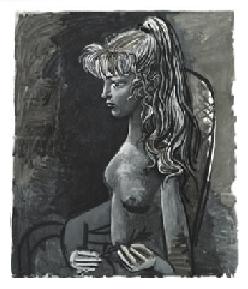 Around 1954 Picasso was using another model by the name of Lydia Sylvette David. She was a shy young girl who was tall with striking looks and wore her hair in a ponytail. They met when he set up a studio near to her boyfriend Toby Jellinek's workshop. Jellinek produced unusual avant-garde metal chairs and Picasso had asked if he could deliver a couple to his studio. When they were being delivered Lydia had come also. Picasso noticed her and later presented her with a drawing that he had done of her from memory. Picasso then asked if she would model for him. Although they had a purely platonic relationship Picasso produced over forty pieces featuring her. Picasso also began work on a series of linocuts that would last until 1964. He meets the printer Hidalgo Arnéra in Vallauris and begins a very productive conversation resulting in the production and printing of two hundred linocuts.
Around 1954 Picasso was using another model by the name of Lydia Sylvette David. She was a shy young girl who was tall with striking looks and wore her hair in a ponytail. They met when he set up a studio near to her boyfriend Toby Jellinek's workshop. Jellinek produced unusual avant-garde metal chairs and Picasso had asked if he could deliver a couple to his studio. When they were being delivered Lydia had come also. Picasso noticed her and later presented her with a drawing that he had done of her from memory. Picasso then asked if she would model for him. Although they had a purely platonic relationship Picasso produced over forty pieces featuring her. Picasso also began work on a series of linocuts that would last until 1964. He meets the printer Hidalgo Arnéra in Vallauris and begins a very productive conversation resulting in the production and printing of two hundred linocuts.
Olga Khokhlova dies.
In1955 Olga Khokhlova who was never legally separated from Picasso dies and Picasso purchases a Villa in Cannes and moves in with Jacquelin Roque. He also exhibits at the Musee des Artes Decoratifs and Bibliotheque National in Germany.
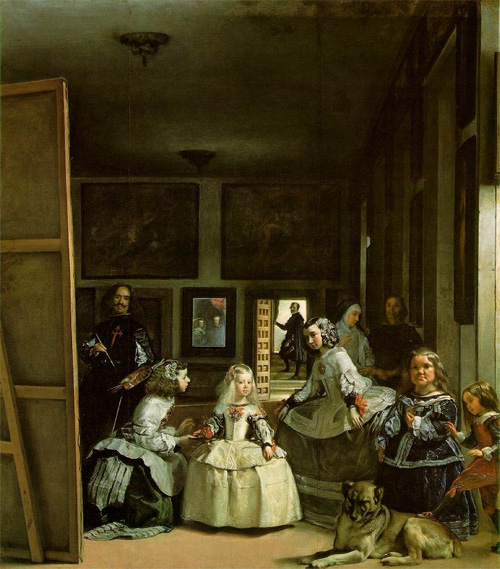
Velázquez's Las Las Meninas (The maids of honour) by Diego Velázquez.
In 1957 Picasso; locks himself away in his studio at the villa La Californie and sets to work on a series of paintings based upon Velázquez's Las Las Meninas (The maids of honour). After four intense months; he emerges with a set of 58 new canvases. All based on a single work and culminating in one unique piece with the origins of forty-four model inspired pieces, three landscapes, nine various pigeons and two free interpretations. Picasso also makes a donation of sixteen ceramic pieces to the ceramics museum in the Royal Palace, Avinguda de la Diagonal.
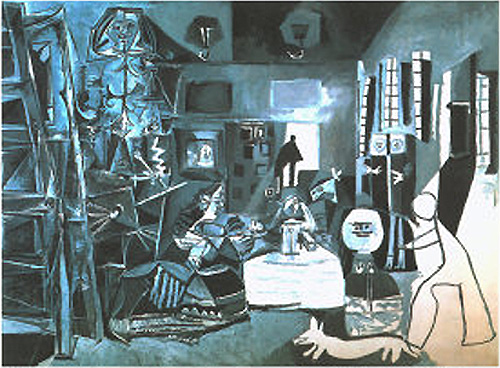
Night scene by Pablo Picasso.
In 1958 Picasso buys the fourteenth-century Chateau de Vauvenargues in the South of France. There he paints numerous studies of Jacqueline. He also produces a series of paintings that are a tribute to the Impressionists. These include a series of re-workings of Le déjeuner sur l'herbe by Edouard Manet's. The Chateau lies on the slopes of Mont Sainte-Victoire which was a constant feature in more than thirty works of Cézanne. Following the purchase, Picasso claimed, " I have bought myself Cézanne's mountains". The Chateau de Vauvenargues will eventually become his final resting place.
Pablo Picasso: The fall of Icarus.
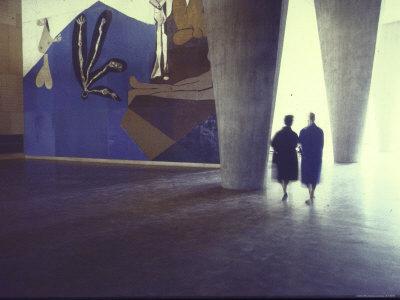
The fall of Icarus by Pablo Picasso.
During this year Picasso agrees to paint a mural for the delegates foyer at the UNESCO building in Paris. Its made up of forty painted wooden panels depicting a beach scene that according to Picasso represented people swimming. Georges Salles the chairperson of the Committee of Artistic Counsellors titles it "The Fall of Icarus"
1959 Picasso finishes producing a series of twenty-seven aquatints that are used to illustrate; La Tauromaquia by José Delgado, It is a book on the art of bullfighting a subject that featured in Picasso work throughout.
Pablo Picasso turns Eighty.
In 1960 the Picasso museum in Barcelona is set up.
In 1961 Picasso celebrates his eightieth birthday. He marries Jacquelin and also finishes his move into the Chateau de Vauvenargues near Aix. Picasso does not stay too long as he finds the property too isolated and Jaquelin finds it too cold. Instead they move to Notre-de-Dame-de-Vie which was a small Provencal manor house overlooking Mougins.
In 1962 Picasso starts to produce large amounts of engravings. He also produces a lot of work in which he incorporates; the theme of the Rape of the Sabine women.
The Rape of the Sabine women.
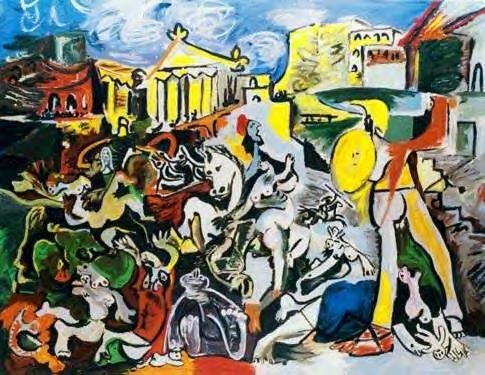
The Rape of the Sabine women by Pablo Picasso.
In 1963 his friends Braque and Cocteau die and the Barcelona museum opens its doors to the public. Owing to Picasso's opposition to the Franco regime its named the Sabartés collection. It houses a collection of works by Sabartés and Picasso. Picasso produces another series based on the theme of Painter and his Model.
In 1964 he produces yet another series based on the theme Painter at his easel.
In 1965 Picasso's secretly taken to the America Hospital in Neuilly where he undergoes surgery on his Gallbladder and Prostrate which its suggested left him impotent. After a period of rest, he concentrated on drawings and a series of 347 etchings. In this year also they leave the Chateau de Vauvenargues as Jaqueline begins to find
In 1966 Picasso's eighty-fifth birthday is commemorated with three consecutive exhibitions in France
Tragically in 1968 his close friend and personal secretary Sebarte's dies. Picasso donates the Las Meninas series and some other works to the museum as a tribute to his friend and also finishes three hundred and thirty-seven etchings with mainly erotic themes.
Then 1969 Following his operation, Picasso begins to paint again and within the year manages to produce one hundred and sixty-five canvasses. The following year the canvases are exhibited at the Palace of Popes, Avignon
In 1970 Picasso makes another large donation of his work that had been conserved in his family's home in Barcelona to the museum. In total, the collection's made up of two thousand early oil paintings and drawings.
Pablo Picasso turns 90
In 1971 Pablo Picasso celebrated his ninetieth birthday. He was commemorated with an exhibition in the Grande Galerie of the Louvre were eight of his paintings are hung. He also becomes the first artist ever to be honoured while still alive.
In 1972 Picasso's admitted into to hospital suffering from severe pulmonary congestion.
On the eighth of April 1973 at the age of ninety-two Picasso died at Mougin. Picasso's buried at Castle; Vauvenargue which he bought in 1958 to escape the ever-increasing attention he received at Cannes. His raised burial mound is topped with his 1933 sculpture, Femme au vase and after 35 years since his death, the site's now open to the public. Throughout his life, Picasso produced over 13 thousand paintings or designs, 100,000 prints and engravings, 34 thousand book illustrations and 300 sculptures, making him the most prolific artist ever.